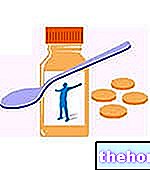Cholinergic antagonists, like agonists, are divided into the muscarinic and nicotinic subgroups, according to their specific receptor affinities.
Nicotinic antagonists include ganglionic blockers and neuromuscular plaque blockers, while muscarinic cholinoreceptor blockers act on the effector organs.
THE antimuscarinic drugs par excellence are atropine and scopolamine; both have the same mechanism of action: that is, they bind perfectly to the muscarinic receptor without inducing a structural modification, therefore the receptor, consequently the transductional cascade, is not activated. Atropine and scopolamine are natural alkaloids obtained respectively: the former from Atropa belladonna or Datura stramonium, the second from Hyoscyamus Niger. The "ingestion of belladonna berries, also known as" cherries of madness "can cause poisoning, which is precisely characterized by hallucinogenic effects. The effects of cholinergic antagonists are exactly opposite to the effects of agonists; they can be summarized as follows:
CNS: Atropine and scopolamine pass the BEE, therefore have visible effects on the CNS. Atropine, in therapeutic doses, has a mild stimulating effect, since it reduces the cholinergic activity on the parasympathetic medullary centers (basal ganglia); for this effect it is used in Parkinson's therapy in association with dopamine precursor drugs (levodopa): in fact, tremor and rigidity in Parkinson's seem to be due to an excess of cholinergic activity, in turn caused by a reduced dopaminergic activity at the level basal ganglia. Scopolamine has more pronounced central effects, causing drowsiness and amnesia in the most sensitive subjects; it seems to be very effective as an anti-kinetosis, since it reduces the cholinergic activity at the level of the vestibular nuclei (in case of movement sickness the muscarinic receptors of the vestibular apparatus are overstimulated and transmit the signal centrally, causing vomiting); scopolamine is administered via trans dermal patches or chewing gum. At toxic doses, scopolamine, and to a lesser extent atropine, cause: excitement, agitation, hallucinations and coma.
EYE: the constrictor muscle of the pupil is regulated by cholinergic activation of the muscarinic type; this activation is blocked with the administration of atropine or other antimuscarinics, therefore the sympathetic dilator activity prevails with evident mydriasis. Other ocular effects of antimuscarinics are: paralysis of the ciliary muscle, or cycloplegia, which results in inability to focus, and reduction of tearing, "sandy eyes".
CARDIOVASCULAR SYSTEM: the effect of therapeutic concentrations of atropine consists in a blocking of the muscarinic receptors present on the vagal fibers, therefore in a reduction of the release of acetylcholine at the level of the sinus node, with consequent tachycardia. The blood vessels are not innervated in such a way. directed by the parasympathetic nervous system, however, atropine may inhibit the dilating effect of parasympathetic nerves on coronary arteries. In addition, almost all vessels contain endothelial muscarinic receptors, which mediate vasodilation, which is blocked with the administration of antimuscarinic drugs.
RESPIRATORY SYSTEM: following the administration of atropine there is bronchial dilation and reduction of tracheo-bronchial secretion; for this reason, antimuscarinics are frequently used to reduce the accumulation of secretions in the airways and the possibility of laryngospasms (anti-asthmatics).
GASTROINTESTINAL TRACT: the blocking of muscarinic receptors has reductive effects on motility (reduction of the contracting activity of the parasympathetic) and on secretory functions, in fact they are adjuvants in anti-ulcer treatment. However, given that the gastrointestinal function is also modulated by endogenous hormones and neurotransmitters non-cholinergic, gastrointestinal activity cannot be completely abolished even with a total block.
GENITOURINARY TRACT: the antimuscarinic activity induces a relaxation of the smooth muscles of the ureters and the bladder wall, thus reducing the emptying of the bladder.
SWEAT GLANDS: Atropine suppresses thermoregulatory sweating; this effect causes an increase in body temperature known as “atropine fever”.
Some of these effects are exploited from a pharmacological point of view to obtain a "therapeutic action, such as: the" anti-Parkinson, anti-kinetotic, anti-asthmatic, anti-ulcer, pupil dilation effect to analyze the fundus of the eye, adjuvant for infectious diseases of the " urinary system, amnesic in the obstetric field.
The side effects of anticholinergics are consequently referred to a block of cholinergic activity: mydriasis, cyclopegia, mental confusion, constipation and water retention.
Atropine is a remarkably safe drug at therapeutic doses, however atropine poisoning has occurred due to attempts to induce hallucinations, or worse, suicide. Intoxicated subjects have hyperthermia, dry mouth, mydriasis, tachycardia, hot and red skin , psychomotor excitement and hallucinations, these effects are recalled by the popular saying "hot as a hare, dry as a bone, blind as a bat, red as a turnip, mad as a chicken".
More articles on "Antimuscarinic Drugs - Atropine and Scopolamine"
- Indirect cholinomimetic drugs
- Antinicotin drugs




























